Ask the Editor: Polymeric LC Columns
E-Separation Solutions
Polymer-based columns still are widely used in size-exclusion chromatography (SEC) and ion chromatography-ion-exchange chromatography - they have always been used in these modes, even back in 1987.
An LCGC reader recently submitted the following question:
In your August "Column Watch" column (1), you noted that one of the HPLC experts had predicted 20 years ago that polymeric LC columns would rise in popularity much faster than silica-based columns. Why hasn't that happened? What are their limitations?
LCGC's "Column Watch"" target="_blank">"Column Watch" columnist Ron Majors provides us with the following answer:
"In reversed-phase chromatography, silica gel-based bonded phase microparticulate columns still yield two to three times the efficiency of polymer-based columns. So, unless one really needs to work at very high pH beyond the limits of silica, most people still prefer to stick with the more efficient columns. Recently, with the introduction of high-pH silica-based and hybrid columns that can be used up to pH 12, one can achieve high efficiency and high pH capability. Polymer-based columns still are widely used in size-exclusion chromatography (SEC) and ion chromatography-ion-exchange chromatography - they have always been used in these modes, even back when the 1987 expert survey was conducted. Polymer columns are able to withstand the more rigorous conditions used in ion exchange where concentrated buffers and wide-range pH adjustment are useful in controlling separation selectivity. In SEC, polymeric packings can withstand strong solvents - such as tetrahydrofuran, o-dichlorobenzene, and hexafluoroisopropanol - and high temperatures (needed for polymer solubility) where silica-based packings would be stressed. Silica-based packings with particle diameters less than 3 µm have become popular in the last few years; polymeric packings for the above modes and in this particle size range are not readily available. So, these are some of the reasons why polymeric packings have not taken over. Besides, one of the strong advocates interviewed in the 1987 survey worked for a polymeric column manufacturer!"
Reference
(1) R.E. Majors, LCGC 25(8), 692 (2007).
Questions?
LCGC technical editor Steve Brown will answer your technical questions. Each month, one question will be selected to appear in this space, so we welcome your submissions. Please send all questions to the attention of "Ask the Editor" at lcgcedit@lcgcmag.com. We look forward to hearing from you.
Troubleshooting Everywhere! An Assortment of Topics from Pittcon 2025
April 5th 2025In this installment of “LC Troubleshooting,” Dwight Stoll touches on highlights from Pittcon 2025 talks, as well as troubleshooting advice distilled from a lifetime of work in separation science by LCGC Award winner Christopher Pohl.
Study Explores Thin-Film Extraction of Biogenic Amines via HPLC-MS/MS
March 27th 2025Scientists from Tabriz University and the University of Tabriz explored cellulose acetate-UiO-66-COOH as an affordable coating sorbent for thin film extraction of biogenic amines from cheese and alcohol-free beverages using HPLC-MS/MS.
Quantifying Microplastics in Meconium Samples Using Pyrolysis–GC-MS
March 26th 2025Using pyrolysis-gas chromatography and mass spectrometry, scientists from Fudan University and the Putuo District Center for Disease Control and Prevention detected and quantified microplastics in newborn stool samples.









